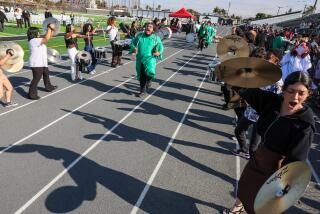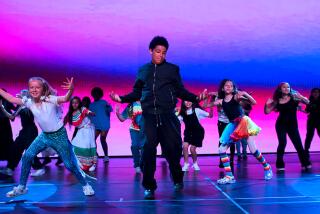SANTA ANA : A Hands-On Approach to Music
Harrison, an excitable 5-year-old with a mischievous smile, held the French horn an inch from his face and peered at its ornate piping. Although an optic nerve disease has gradually robbed his sight, the youngster was still able to study the mysterious, glinting instrument.
âWhat the heck is it?â he asked with a giggle as his hands explored the cool metal.
Around him Thursday morning, a dozen of his classmates at the Blind Childrenâs Learning Center were getting similar hands-on introductions to instruments brought by the visiting Orange County Philharmonic Music Mobile.
The music van, loaded with everything from a violin to a trombone to a triangle, makes stops at classes across the county to educate children about orchestras and their music. More than 25,000 Orange County students participated in the program last year.
The Music Mobileâs volunteers had a different sort of audience Thursday. The children banging on the snare drum and cradling the cello were younger than usual--itâs a preschool class of 5- and 6-year-olds--all but one of them sight-impaired.
âFor our kids, this is just a great, great opportunity,â said Patty Salcedo, a teacher at the learning center. âIt energizes them, and it motivates them to be interested in music. Music is so important to them.
âYou know, we can sit and listen to music all day, but because they canât see, they donât know how itâs being produced, how musicians make it,â said Salcedo, who has taught at the center for four years. âBut to touch an instrument, to feel it, opens up new things to them.â
The majority of the centerâs 50 students have sight disabilities of varying degrees. More than half have some sight, ranging from being able to discern light to the ability to read large type, school official Linn Morgan said. About 20% are completely blind, she said, while another 20% are fully sighted children.
The students with unimpaired vision are used as class role models of sorts, Morgan said. Their presence encourages the others to interact with sighted children and receive a view of the world from a peer.
The lessons taught Thursday were of a more melodic nature. The students laughed and cheered one another as they took turns plucking strings and pounding out notes on a xylophone. They played conductor to an invisible orchestra, and they rocked in their seats when the presenters turned on a tape of a real one.
One boy examined a violin and asked where he was supposed to blow to produce a noise.
Another student, a 5-year-old girl named Alex who has partial sight, startled herself with her initial beat of a drum. But by the third blow she was smiling broadly.
âBecause they canât see, music is going to be so important to them,â Salcedo said as she watched one of her students run his fingers along the curves of a cello. âA lot of people think (sightless people) have better hearing, but thatâs a misconception. We have to teach them to hear better, though, because theyâre going to have to get so much of life through their ears.â
More to Read
The biggest entertainment stories
Get our big stories about Hollywood, film, television, music, arts, culture and more right in your inbox as soon as they publish.
You may occasionally receive promotional content from the Los Angeles Times.










